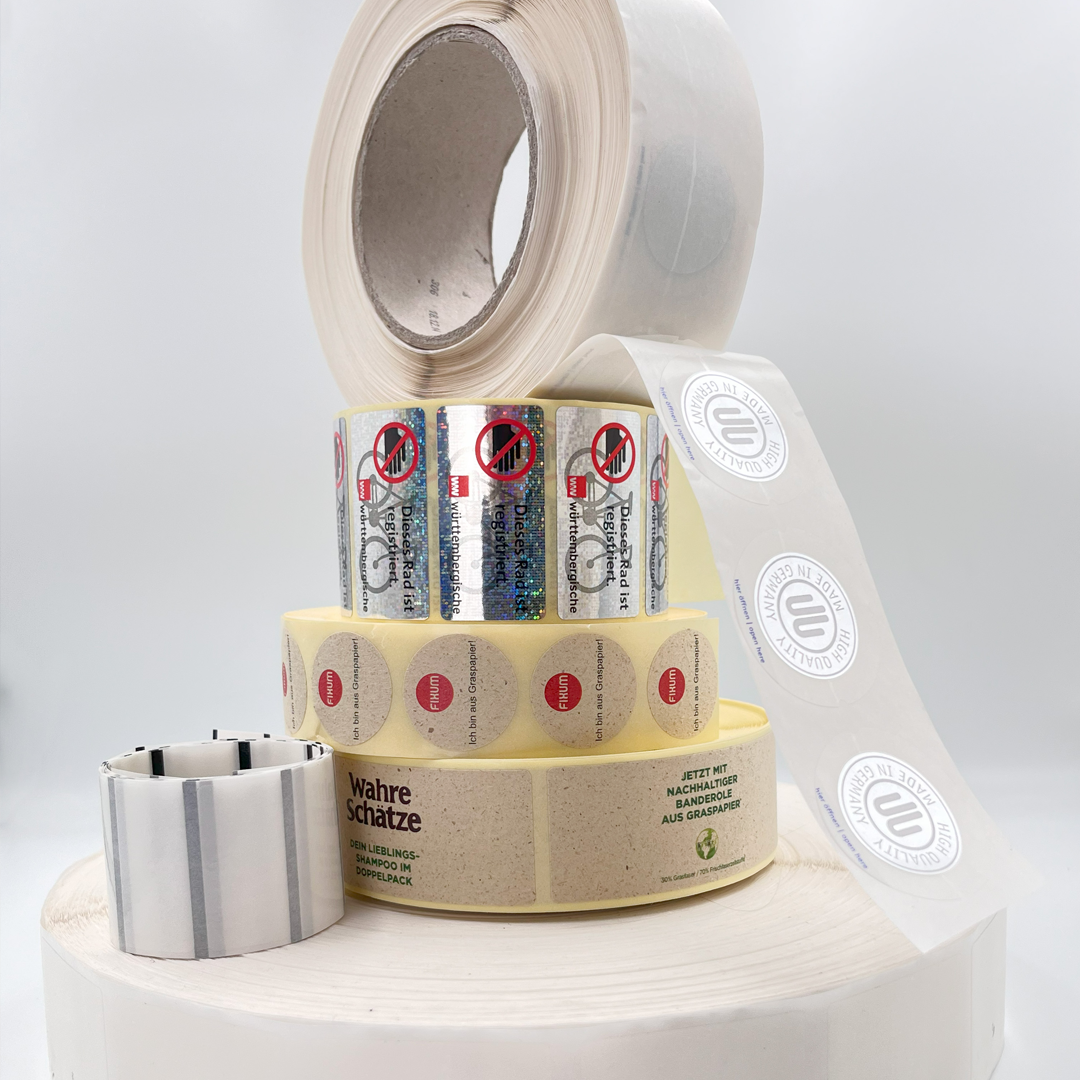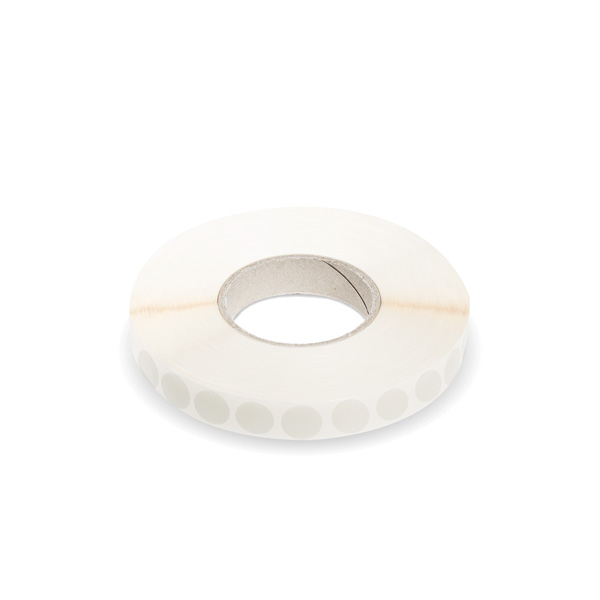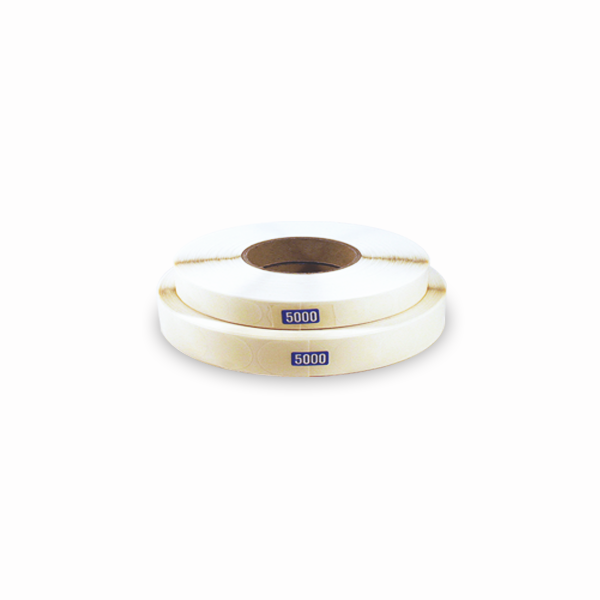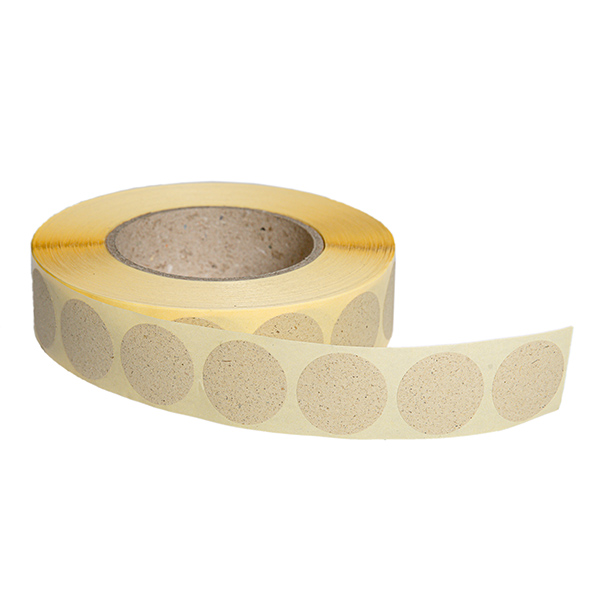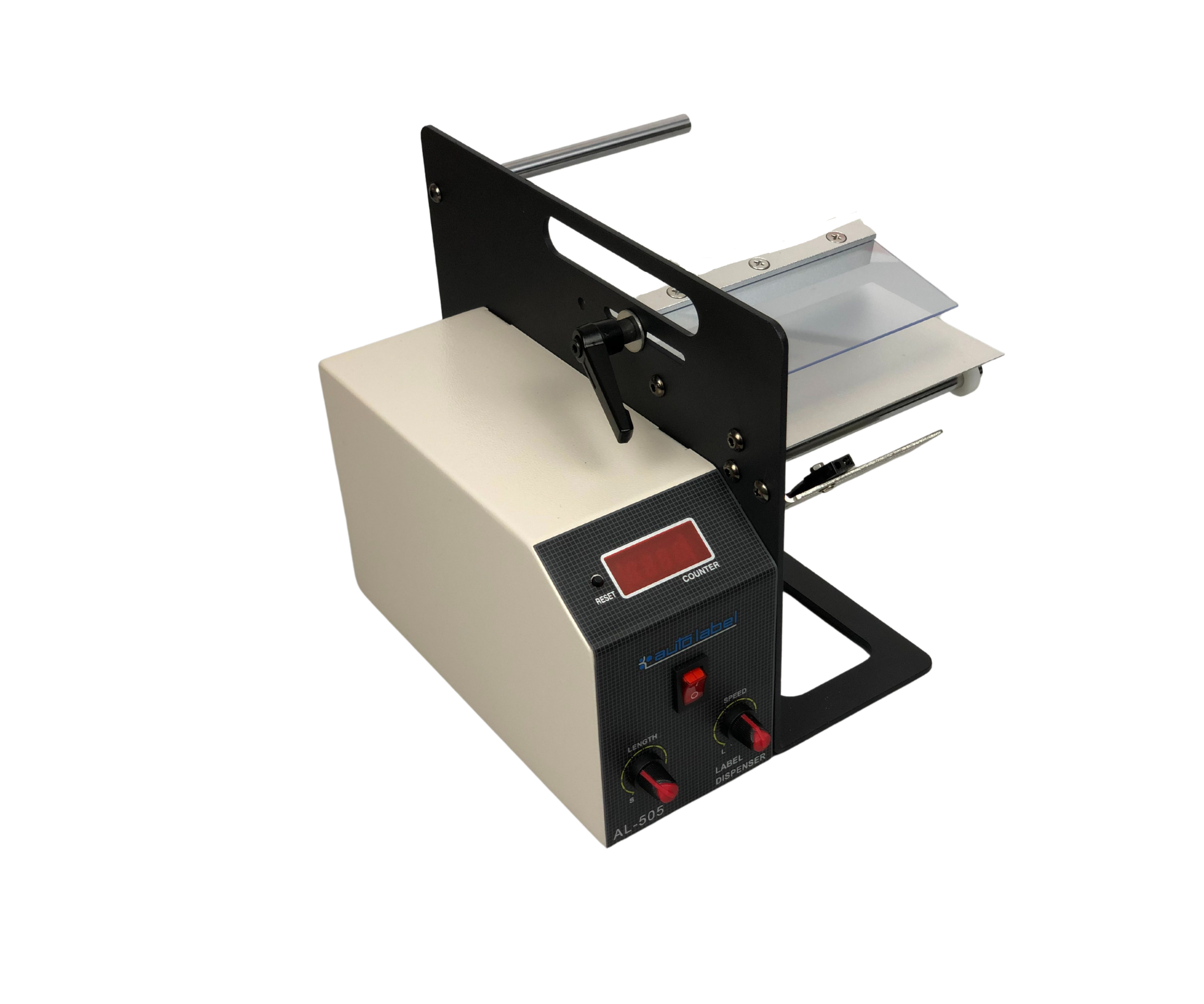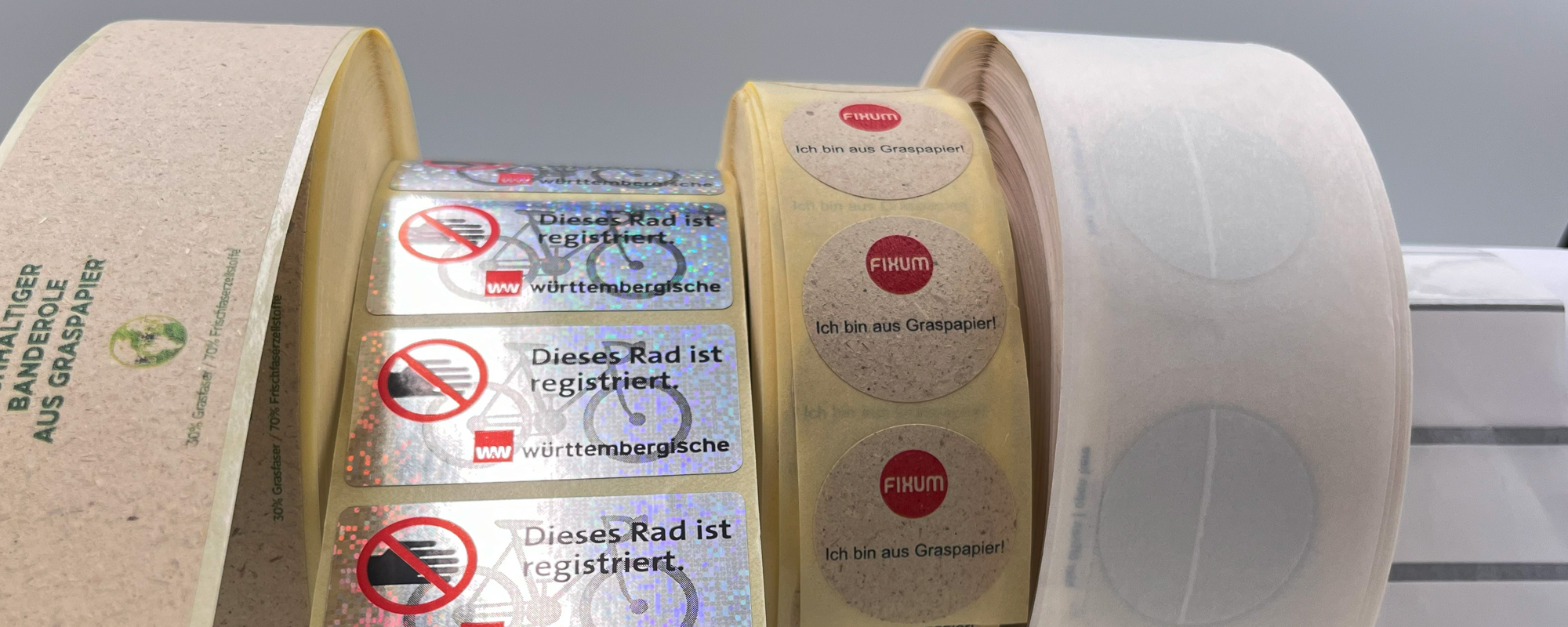
Labels are indispensable for labelling, safety and marketing in the modern packaging industry.
Labels: The inconspicuous heroes of the packaging world
An introduction to the world of labels & labelling
What are labels?
Labels are small, usually self-adhesive pieces of paper or film that are attached to products, packaging or containers to provide information or securely seal packaging. Their origins date back to ancient Egypt, where papyrus scrolls were labelled. Then as now, labels have become an integral part of our everyday lives. They are not only used for labelling and information, but also for branding and security.
In the modern packaging and logistics industry, labels play an important role by communicating product information and enabling the traceability of goods. With the help of labels, consumers can quickly obtain important information about a product and companies can effectively present their brand. Labels are therefore indispensable tools in today's retail sector and make a significant contribution to the success of a product.
Types of labels and their functions
Product labels
Product labels are extremely important sources of information for consumers. They contain essential information such as the exact product name, a detailed list of ingredients, the weight or volume of the product and, of course, the manufacturer's details. In this way, product labels provide a transparent overview of the product and enable customers to make informed purchasing decisions. They also serve to ensure the safety and protection of consumers by containing important warnings or instructions for use. In short, product labels are indispensable companions when shopping and should therefore always be read and observed carefully.
Examples of product labels:
- A label on a jam jar with information about the fruit used, the sugar content and the bottling date.
- A label on a face cream with information about the ingredients, application method and manufacturer.
- A label on a bottle of wine with information about the alcohol content, the winemaker and the bottling date.
Shipping labels
Shipping labels play a central role in logistics. Without them, it would hardly be possible to correctly allocate and deliver goods and consignments. This is because shipping labels contain important information such as the recipient's address, the sender's contact details and special instructions for handling the consignment. They are therefore not only used for identification purposes, but also to ensure that the shipping process runs smoothly. It is therefore essential that the shipping labels are filled in carefully and correctly to avoid delays or mix-ups. The companies use these labels to ensure efficient and smooth logistics processing.
Examples of shipping labels:
- Standard shipping labels: A label with the recipient's address, sender's address and a barcode for shipment tracking.
- Refrigerated shipping labels: A label with the words "Keep Refrigerated" and a temperature symbol for products that need to be transported at low temperatures, or a label with the words "Frozen" and an ice symbol for frozen products.
- Dangerous goods labels: A label with a danger symbol and special handling instructions for the transport of chemicals or a label with a flame symbol for flammable liquids, indicating that the package must be handled with care.
Warning labels
Warning labels are indispensable indicators of potential hazards that may emanate from a product or tool. They not only serve to inform the consumer, but are often also required by law to ensure the safety of the user. They therefore fulfil an important protective function and should always be observed and read carefully in order to avoid accidents or damage. Companies are obliged to display warning notices in a clearly visible position in order to make potential risks transparent and demonstrate responsibility. Ultimately, warnings serve to protect people and the environment and therefore make a decisive contribution to safety when handling products.
Examples of warning labels:
- Chemical and cleaning product warning labels: a label on a cleaning product warning of toxic vapours and indicating the need for ventilation or a label on a drain cleaner with warnings about mixing with other chemicals and a symbol for "Corrosive".
- Construction site and safety warning labels: A label on construction site materials warning of the hazards of heavy machinery and requiring protective clothing or a label on a safety helmet indicating that the helmet protects against impact and should be checked regularly for damage.
Promotional labels
Promotional labels are a valuable marketing tool to attract the attention of potential customers and inform them of current discounts, special offers and promotions. Through targeted placement on products or packaging, companies can communicate their message in a targeted manner and arouse consumer interest. These labels are not only used for promotion, but also increase brand awareness and promote sales. With creative designs and appealing content, promotional labels become effective advertising media that sustainably support the success of a marketing campaign.
Examples of promotional labels:
- Discount labels: a label on a shampoo bottle with the words "20% off" or "Now only €4.99" or a product promotion with "Buy 1, get 1 free".
- Cross-promotion and bundle offers: A label on a product that offers a discount on a complementary product when the main product is purchased at the same time, e.g. "When you buy a shampoo, you receive a 50% discount on the matching conditioner".
- Limited editions and special editions: A label on a drink that says "Limited Special Edition" or "Available for a short time only" or a label on a product that says "Anniversary Edition".
Barcode and QR code labels
Barcodes and QR codes enable products to be quickly recorded and tracked in retail and logistics. Barcode and QR code labels are indispensable tools in modern merchandise management. By using barcodes and QR codes, products can be efficiently recorded and tracked in retail and logistics. These technologies make it possible to speed up processes and minimise errors during data capture. They offer a reliable method of ensuring the identification of products and keeping a close eye on stock levels. Barcode and QR code labels therefore enable effective inventory control and optimise product tracking along the supply chain. Their versatility and reliability make them an indispensable tool for companies to increase their efficiency and ensure that their business processes run smoothly.
Examples of barcode and QR code labels
:- Inventory management: a label with a barcode on a warehouse shelf that identifies the product's stock position and is used for quick replenishment or a label with a barcode on a product container that is scanned in the warehouse to update inventory in real time.
- Retail products: A barcode label on a pack of spaghetti that is scanned at the checkout to capture the price and complete the sale.
- Product information and instructions: A QR code label on an electronics package that leads to an online manual or installation video.
Closure labels
Closure labels ensure the integrity and authenticity of your products by showing whether a package has been opened or tampered with. These labels ensure that your products remain original and intact. They act as an effective safety feature that shows at a glance whether the packaging is intact. Rely on these labels to offer your customers maximum security and confidence.
Examples of closure labels:
- Labels in the food sector: a closure label on a jar of jam that tears when first opened to show that the jar is intact, or a freshness seal on packaging to ensure that the contents remain fresh and flavour-sealed.
- Safety seals on pharmaceutical products: A closure label on a medicine box that ensures the contents have not been tampered with prior to sale.
- Safety and hygiene seals in the cosmetics sector: A closure label on a tube of face cream to ensure that the cream has not been opened before purchase, or a label on a lipstick to ensure that the product is unused.
Materials for labels
Labels are an essential part of product packaging and play a crucial role in communicating information, brand presentation and product safety. Choosing the right labelling material is of great importance, as it has to withstand different requirements and conditions. Whether for retail, logistics, the pharmaceutical industry or the food sector - every label requires specific properties in order to fulfil its function optimally. From paper and plastic labels to special materials such as metal and thermal labels - the variety of materials available enables customised solutions for almost any application. This introduction provides an overview of the most common labelling materials and their respective advantages and disadvantages to make it easier to choose the right material.
Paper labels
Paper labels are one of the most commonly used labelling materials. They are versatile, cost-effective and can be used for a wide range of applications. Here are the main advantages, disadvantages and areas of application of paper labels:
Advantages:
- Easy to print
- Individual design options in terms of size, shape and colour
- Simple processing by hand or machine
- Labels made from speciality papers look classy and have a special feel
- More environmentally friendly than film or plastic labels, as they can be made from recycled fibres and are easy to recycle
Disadvantages:
- Less durable than other materials
- Sensitive to moisture
- Can tear more quickly compared to film labels
Application:
- Retail products: For labelling food and other consumer goods as well as for product information and branding
- Logistics and shipping: For address labels, shipping labels and warehouse labelling, easily printable and barcodeable
- Office and administration: For labelling files, folders and documents
- Pharmaceutical industry: For labelling medicines, package inserts and for sealing packaging
- Packaging and gifts: For designing packaging, gift items, invitation cards or as logo stickers, particularly popular during the Christmas period.
Foil labels
Foil labels are a popular choice when it comes to durable and resistant labels. These labels are made of plastic films such as polypropylene (PP), polyethylene (PE), polyester (PET) or polyvinyl chloride (PVC) and offer numerous advantages, but also some disadvantages. They are ideal for applications where the labels have to withstand high loads.
Advantages:
- Waterproof and durable: film labels are resistant to moisture, water and many chemicals, making them ideal for products that are stored or transported in humid or harsh environments.
- High resistance: They are resistant to abrasion, tears and other physical damage, which significantly increases their durability compared to paper labels.
- UV resistance: These labels are insensitive to UV radiation and do not fade. PP has a higher resistance to UV radiation than PE. (May yellow depending on adhesive, storage time, etc.)
- Flexibility: film labels are flexible and adapt well to uneven or curved surfaces, making them versatile. PE is more flexible than PP.
- Design and printing: They offer excellent print quality and can be designed in a variety of colours and designs, including transparent variants that allow for a "no-label look".
- Space-saving: multi-page labels for products with a lot of information in a small space (so-called multipage or fanfold labels)
Disadvantages:
- Less environmentally friendly: film labels are more difficult to recycle than paper labels, which makes them less environmentally friendly. They therefore contribute to the plastic waste problem.
- Over time, the labels may appear yellowish depending on the adhesive and external influences
- PVC films usually contain plasticisers
Application:
- Food industry: Film labels are often used for products that are exposed to moisture or temperature fluctuations. Be it for labelling cheese in the chiller cabinet or frozen products. They adhere reliably even under these conditions and remain easy to read.
- Cosmetics and pharmaceutical industries: In these sectors, resistance to moisture and chemicals as well as high print quality are crucial. Film labels are often used for creams, lotions and medicines.
- Industrial applications: Industrial applications place high demands on labels, especially in sectors such as the automotive industry, mechanical engineering and construction. These sectors require labels that can withstand extreme conditions. Film labels are particularly suitable for technical and safety-related labelling.
- Outdoor products: Outdoor products such as garden products, building materials and tools benefit from the UV-resistant properties of special film labels that have been developed for outdoor storage and use.
The role of labels in the packaging industry
Labels play a central role in the packaging industry and fulfil a variety of important functions that are essential for the success of products and the efficiency of business processes.
- Information transfer: Labels are essential for providing essential product information that is required by law and provides important information to the consumer. They contain information such as ingredient lists, nutritional information, warnings, expiry dates and instructions for use. This information helps consumers to make informed purchasing decisions and ensures compliance with legal regulations. In many industries, detailed labelling information is also crucial for product safety and quality. They provide consumers with a transparent overview of what they are buying, promoting trust in the brand and the product.
- Marketing and branding: Labels are an important part of marketing and contribute significantly to branding. With appealing designs, colours and logos, they help to establish the brand identity and make the product stand out on the shelf. A well-designed label can attract the attention of consumers, create an emotional connection to the brand and influence the perception of the product. In addition, companies use labels for special promotions, discounts or limited editions to increase interest and demand.
- Security and authenticity: Closure labels and security features are essential to protect against counterfeiting and tampering and to guarantee the authenticity of the product. Security features such as holograms, special seals or stickers that are destroyed when opened help to ensure that the product has not been opened prematurely or tampered with. These labels give customers the assurance that they are receiving an original and undamaged product, while protecting the integrity of the brand.
- Traceability and logistics: Labels with barcodes or QR codes play a crucial role in tracking and managing products throughout the delivery process. They enable efficient tracking and management of stock levels, improve inventory accuracy and help to quickly identify products during logistics. By integrating technologies such as barcodes and QR codes, companies can optimise their supply chains, reduce errors and make the entire process from production to the end consumer more efficient. These technologies also facilitate the traceability of products in the event of recalls or quality issues, which is crucial for risk management and regulatory compliance.
Conclusion:
Labels are central to the modern packaging industry. They fulfil essential functions by providing information, ensuring product safety and supporting the marketing of products. Their role ranges from transparent information and product protection to strategic branding.
As specialists in this field, we are at your disposal. If you have any questions or require further information, please contact us at any time.


